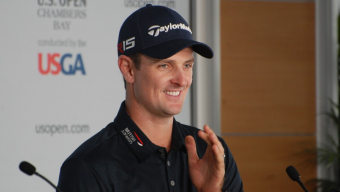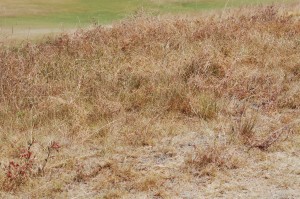UNIVERSITY PLACE, Wa. – Justin Rose, the 2013 U.S. Open champion, said Wednesday that the first major ever played in the Pacific Northwest could turn out to be a survival of the fittest.
“I think there’s a big fitness element this week,” he said during a press conference at Chambers Bay. “There are a lot of us who have been here and probably preparing harder for this championship than many others. Because of that, there’s an even bigger physical demand.”
Although traversing the links-style course isn’t quite like scaling Mt. Rainier, the elevation changes at Chambers Bay figures to make the golfers huff and puff along the way.
“There’s a lot of research that goes into this,” said Mike Davis, the United States Golf Association Executive Director, “and I will tell you that this year we will have 21 minutes worth of walking between tees and greens. “Put that in perspective. Last year at Pinehurst we had 13 and a half minutes and Merion, the year before, it was 11 minutes. We all know this is a tough walk in Chambers Bay. It’s a tough test of golf.”
Looking trim and fit when he walked into the media interview room, Rose sipped from a water bottle.
The seven-time PGA winner, who is among the favorites heading into Thursday’s first round, arrived last Thursday and has been diligently learning the ups-and-downs (literally) of the eight-year-old course.
He said there is a fine line between being well prepared and burned out.
“One of my keys was to practice hard on Friday, Saturday and Sunday, but converse energy Monday and Tuesday. At the end of the day,” he said, “you want to be 100 percent prepared Thursday morning and you need your best stuff on the weekend.”
Among the observations Rose has made during his preparations:
* On the lack of chatter about the rough: “I’ve driven the ball very well in practice so I haven’t been in it that much. But not to say it won’t be in play. I think fairway bunkers are as much in play as the rough, maybe more in play than the rough. So I feel like if you drive the ball well, you can definitely hit these fairways. They’re relatively wide. On the 18th, I spent a little bit of time in the left rough today because there’s the bunker.
“With the tee being forward, the par-4 tee, there’s a bunker (Chambers Basement) that you need to avoid out there, about 320, 325, which sounds like a long way, but with the way the ball is rolling it’s very much in play.
“The left rough is almost your miss. It’s very brown, very wispy, very soft almost feeling. It’s the kind of rough that you feel like you’re going to get a big flier out of. I hit a couple of shots and it actually came out relatively shot, which surprised me. There are fescue areas, left of 8, for example. There’s some terrible spots out there, for sure. It’s just about learning which side of the hole. Typically there is a side of the hole on each hole, so it’s about managing your misses, I suppose, the best you can.”
* On which hole he would be most relieved to walk away with a par: “Potentially 18 on Sunday. I would say there’s a couple of dangerous holes out there. The stretch of 4, 5, 6, 7, that’s definitely a stout run of holes. I’d probably say No. 7. That’s the one hole in practice that if you get the ball running short of the green into that bunker, especially short right, that bunker shot is certainly no — nothing to look forward to. I’ll tell you, if you get through 7, you’re picking up more than half a shot on the field every day. I think that will be the hardest hole in my opinion.”
* On the 281-yard 12th hole: “It’s a drivable par-4, but it’s not an extremely severe green. To be honest, it’s a bit of a bowl. It’s not severe in terms of some of the other holes, kick the ball away and funnel off potentially 30, 40 yards. I actually think that 12 will probably play one of the easier holes on the golf course, probably the easiest.
“Depending where they put the pins, you’re going to see in eagles, if it there’s a back left pin. You’re definitely going to see some excitement on that hole. But I don’t think that you’re going to see tons of double bogeys, as well as eagles. I think it’s going to be a 4-3 hole, mainly, a couple of bogeys, and the odd eagle. It’s going to be a fun hole.”
* On the importance of avoiding double-bogeys: “You know, you might see a little bit of tennis going on a couple of greens. Potentially the bunker on 7, if you get down in the bunker, if you don’t get it up again, it could end up in your footprint, as it did to me yesterday in a practice round. That’s a potential hole where you want to at least be aware of what can happen. So if you are down in that bunker, you do your best to hit a safe bunker shot. But it’s a 30, 40-yard bunker shot up a hill. It’s pretty hard to get it up again. There are holes where you’re going to see some stuff like that. No. 8, maybe. Guys hitting it left off the tee, could be all sorts of stuff going on there. Just trying to keep my eyes down the middle of the fairway as best I can.”
* On why European golfers have done so well in the U.S. recently: “I don’t think there’s any great reason, other than there’s been a lot more Europeans playing a lot more golf in the States in the last five, ten years. A lot of us are making the predominant – our schedule is predominantly U.S. focused. And these tournaments are staged on such a huge scale that it can be quite overwhelming, I think week in, week out, PGA Tour event definitely feels a lot closer to the — from a crowd point of view and a staging point of view. The more comfortable you get playing in America I think helps you adjust to these tournaments a lot quicker, and I think that’s the only real reason I can say that there’s been such a strong showing in the last five, ten years ago or so.”






















